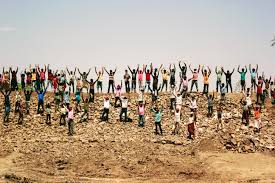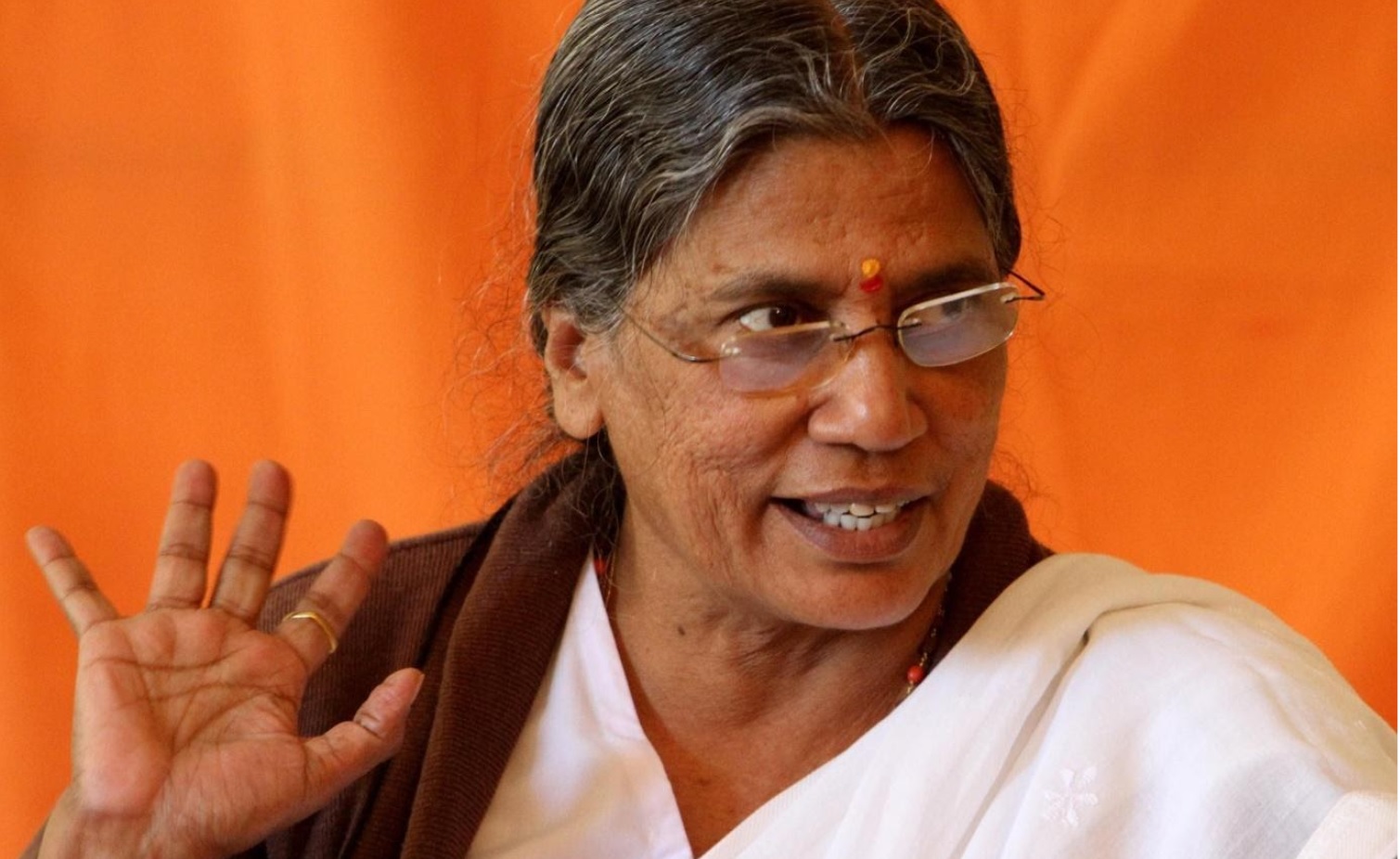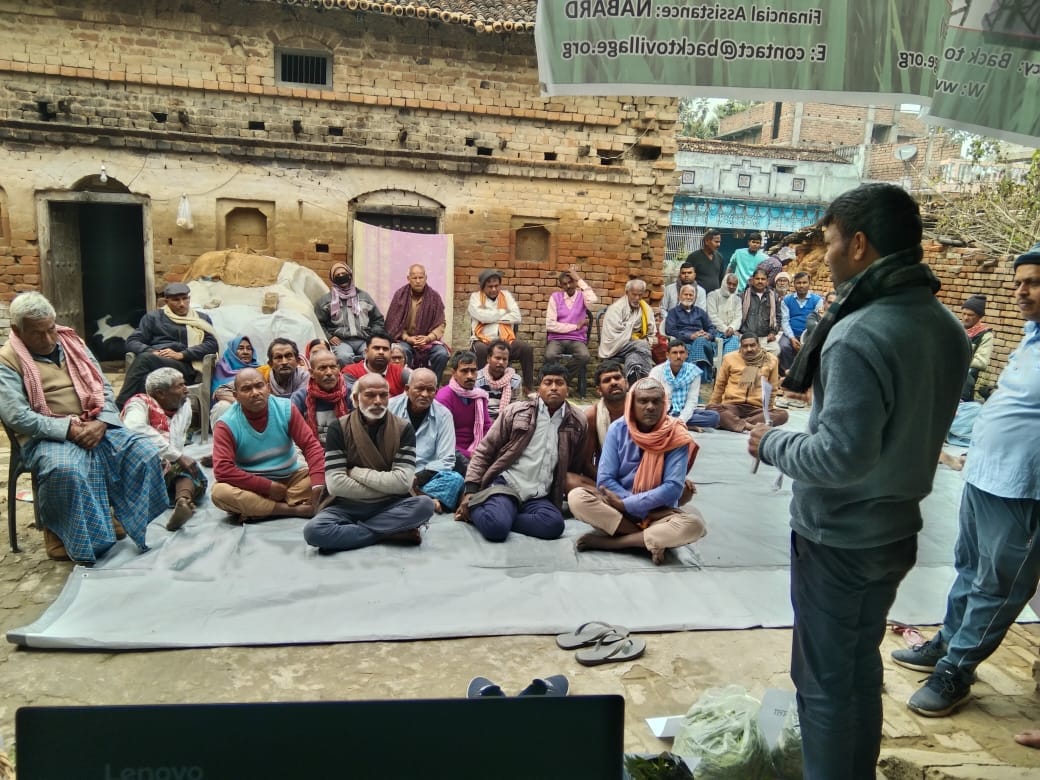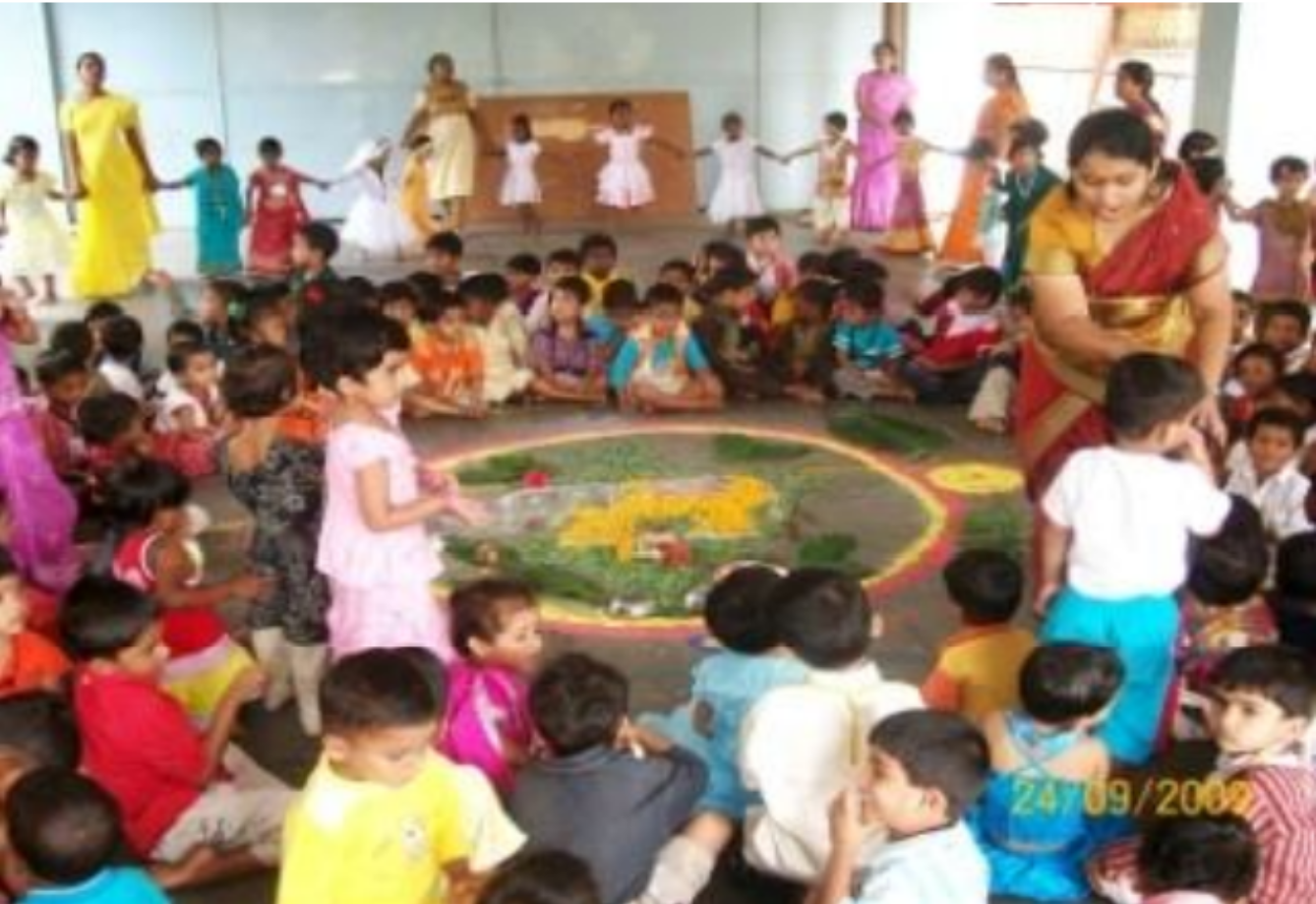“In the early years of volunteering for Youth For Sewa, I came to the realization that the kind of life I live is a very cozy and comfortable life. I have a home, I work in a plush office but the ground reality is very different. There are people who struggle to have decent clothing. Even books to read and write are not available. This is what made me think that I have to get out of this comfortable existence and do something for our society.”
Who is Ashwin Busare?
 Ashwin Busare is originally from Gulbarga, a small town near Hyderabad. Ever since he was a child he has always wanted to help the people of his community in some way or another. Despite this passion, he looked over this fact for most of his life and chose to pursue a conventional career. He studied in Gulbarga up till the 10th grade and then went to Mysore to pursue his career choice of a Software Engineer. After finishing his studies in Mysore he worked at WIPRO, an Indian company that provides IT services. While working there he had started attending Shakha of RSS (a daily 90 minute program for mind, body, and spiritual wellness). At Shakha, he met a social worker named Shobit Mathur, the Executive Director of Vision India Foundation, who convinced him to begin volunteering for Youth for Sewa. Youth for Sewa (YFS) is a non-profit organization that inspires the youth to volunteer and provides opportunities to serve the community. This experience as a part time volunteer only strengthened his will to make a difference as he was exposed to many communities where people were struggling to fulfill their basic needs.
Ashwin Busare is originally from Gulbarga, a small town near Hyderabad. Ever since he was a child he has always wanted to help the people of his community in some way or another. Despite this passion, he looked over this fact for most of his life and chose to pursue a conventional career. He studied in Gulbarga up till the 10th grade and then went to Mysore to pursue his career choice of a Software Engineer. After finishing his studies in Mysore he worked at WIPRO, an Indian company that provides IT services. While working there he had started attending Shakha of RSS (a daily 90 minute program for mind, body, and spiritual wellness). At Shakha, he met a social worker named Shobit Mathur, the Executive Director of Vision India Foundation, who convinced him to begin volunteering for Youth for Sewa. Youth for Sewa (YFS) is a non-profit organization that inspires the youth to volunteer and provides opportunities to serve the community. This experience as a part time volunteer only strengthened his will to make a difference as he was exposed to many communities where people were struggling to fulfill their basic needs.
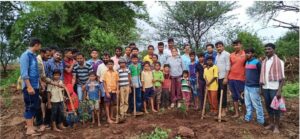 For the next one and a half years, he continued volunteering for Youth for Sewa on weekends while working as an Engineer on weekdays. After seeing Busare’s consistency with volunteering, Mathur asked him to visit Orissa to see the work of Vanawasi Karan Ashram (a social welfare organization working for tribals) for 10 days. They had established tuition centers (centers for students to attend and receive additional help on school subjects and homework) deep inside the forests. These areas were under the control of a Naxalite group (Left-wing armed radical group) and as a result the people in there areas were excluded from the rest of the world. Seeing how detached the children in these villages were from the rest of the world convinced him to leave his job at WIPRO and work at Youth for Sewa full time.
For the next one and a half years, he continued volunteering for Youth for Sewa on weekends while working as an Engineer on weekdays. After seeing Busare’s consistency with volunteering, Mathur asked him to visit Orissa to see the work of Vanawasi Karan Ashram (a social welfare organization working for tribals) for 10 days. They had established tuition centers (centers for students to attend and receive additional help on school subjects and homework) deep inside the forests. These areas were under the control of a Naxalite group (Left-wing armed radical group) and as a result the people in there areas were excluded from the rest of the world. Seeing how detached the children in these villages were from the rest of the world convinced him to leave his job at WIPRO and work at Youth for Sewa full time.
After joining Youth for Sewa, Ashwin Busare eventually became a full time volunteer and went to rural areas of the city. This gave him even better exposure as to what is happening in these underdeveloped villages and provided him with ideas of what he can do to help them out. He started projects on rural development. Youth for Sewa helped foster his projects. They provided him with funds that were needed and provided project coordinators with the necessary connections in order to accomplish the project’s objective. Along with this, YFS also provided like minded volunteers to help the project gain momentum and run smoothly.
Starting the Project
The planning stages of a project are some of the most important ones, he told us. They hold just as much value as the execution stages, if not more. For each social change project, an immense amount of dedication and intricate planning is needed. In fact Ashwin Busare, spent almost 2 years to plan his first project of rural village development.
This project all started with a vision and inspiration. During his 5 years as a pracharak (traveling full time volunteer), he toured many rural villages throughout India. At this time, he started to notice that there was a lot of work to be done in these places in order to make them more developed. He was also able to identify the problem with the rural economy, only men were working and the women were not trained to work for enough pay He also noticed the lack of infrastructure and developmental programs that could develop the youth. Over all, the village seemed very underdeveloped and he believed that if few important changes could be made it could stimulate the village’s economy, empower women, and improve the quality of life for children growing up in rural environments.
He understood that many women were willing to undergo skill development training however they lacked the facilities and opportunities. So he started a skill development program for women. At the start of the project, they took 26 women, a small number, and taught them the skill of sewing with pre-owned industrial sewing machines. This program went on for 6 months and by the end their income increased from Rs 500 to Rs 2000 mainly because they started getting orders for a variety of clothing like shirts, pants and school uniforms. Gradually, an increasing number of orders started coming in. At the end of the 6 months the program was such a success that they expanded this women empowerment program to other villages so that more women could participate. Along with these renewed efforts, they also introduced new development projects such as replenishing wells, digital literacy centers, and tuition for students.
Another problem that was identified during the planning process was the way the village’s funds were being utilized. The Gram Panchayat, village council, is in charge of managing the village’s funds that they receive from the central government. The problem comes when these leaders are not motivated to utilize the funds in the best way possible and the villagers themselves are not aware of how this money is being used. As Ashwin Busare explains, “It is not like there are no funds. The government provides plenty of funds but there is a total mismanagement at Panchayat level.” To tackle this issue, Ashwin Busare and his team started talking to the villagers and motivated them to plan effectively. Specifically, they are educating college students of the village about the rules of the Gram Panchayat guidelines book. Their goal is to eventually educate all the village residents so they know the regulations, know the constitution, and feel comfortable with questioning the system when they feel it is wrong.
Empowering the Village
Perhaps, one of the biggest parts of planning and executing a social project is empowerment. No developmental project brings development if only one man keeps working for it. It requires the whole community to become aware, competent to solve the problem by themselves and collaborate as a team. With this at the back of his mind, Ashwin Busare has worked with other change makers from YFS as well as with the villagers themselves in making them partners of change. In each village where these projects are 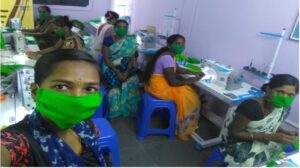 implemented, 2-3 people are stationed to take charge as coordinators. More other people who reside in the village help these coordinators. Through constant interaction and forming deeper bonds with the people of the village, they are able to encourage villagers to become active and work in the developmental projects. According to Busare, villagers from within the village are preferred rather than some other volunteers from cities as it empowers the villagers. He tells us “When these villagers take their problems into their own hands and work in order to implement solutions, it helps build a sense of responsibility within them.” He adds that also without this participation of villagers, these projects would not be possible.
implemented, 2-3 people are stationed to take charge as coordinators. More other people who reside in the village help these coordinators. Through constant interaction and forming deeper bonds with the people of the village, they are able to encourage villagers to become active and work in the developmental projects. According to Busare, villagers from within the village are preferred rather than some other volunteers from cities as it empowers the villagers. He tells us “When these villagers take their problems into their own hands and work in order to implement solutions, it helps build a sense of responsibility within them.” He adds that also without this participation of villagers, these projects would not be possible.
Taking on Challenges
Challenges are faced within every social project. So, what kind of challenges did Busare face?
We may assume that villages would harbor the most resistance to change. After all, these are people who have lived in tight knit groups and followed the same routine that has been passed down generation to generation. These are people who are deeply rooted in their traditions and devoted to their social values so when the prospect of bringing in new ideas and improvements comes in, they are bound to show some resistance. No?
Actually not in the case of the rural development project run by Ashwin Busare. In this particular case, he tells us, due to the work of RSS visits by its leaders in these villages, this problem of resistance to change was not a big issue. However what was a major challenge was to improve work culture, sense of time, quality of work, etc. In the villages, people don’t have a firm sense of time and often turn up late to events. When stitching, sometimes the women have developed previous habits with stitching and will stitch according to their own wish arthur than the specified requirement. Busare tells us, it takes a while to train them and there is also resistance – 50% of the women even ended up dropping out of the first project. However those to stayed on not only greatly improved but became the agents of change in their community.
Another problem Busare pointed out was the issue of migration of workers out of villages. As per census data which we studied, after Mysuru, the twin cities of Hubli-Dharwad had the most migrants: 3,74,230. “How can development happen when so many villagers are leaving seeing that it is easier to find a good job in the city?” Busare asks.
He told us “The villagers wanted change and they didn’t want to leave their homes. The only reason they are moving is that they don’t get any jobs, they don’t get water for farming activities or face other problems. Nobody feels that they should simply go to some big city, stay there, and enjoy it. They have a sense of duty towards their village.” Busare’s rural development project aims to modernize villages and help the village economy so that the workers can stay in the villages.
What was the roughest part of his life as a social change-maker? For Ashwin Busare it was convincing his parents. One of the reasons that this was difficult was because he chose to leave his job as a software engineer at WIPRO in Hyderabad to relocate to Karnataka and take on the challenge of developing rural villages. This was an incredibly tough decision for him to make because he went from someone with a stable job to working for a volunteer organization with literally no pay.
He also faced resistance from his parents due to the fact that they were against the idea of RSS (Rashtriya Swayamsevak Sangh) and once they found out that he was attending shakha (daily program for members of RSS) they were upset. It took a while to convince them and make them understand what RSS really was.
According to Ashwin Busare, this decision to take up the job under YFS as a coordinator was very much worth it as he is content with the difference that he is making in the lives of the rural people.
Success and the Impact
Busare’s work has seen immense success in these villages. Numerous projects have been implemented in each of the 5 focus villages and each has provided a greatly measurable impact that has changed the lives of the people of the village. The lakes which have been neglected by the villagers for years have now been cleaned up by those people who initially neglected them. The lakes went from a place to dump trash, uninhabitable by vegetation and animals, to a place with clean fresh water. Along with this, many wells in the villages were cleaned out as well. These wells are sometimes the only source of water in a village and when wells by a villager’s house are dirty, they have to walk long distances to get water every day. Cleaning out these wells and installing taps in some houses made it so the people of the village had easy access to clean water, ensuring that water scarcity was no longer a problem. Flooding is another major problem in these villages and during monsoon season, many buildings get damaged and vegetation gets destroyed. Busare and his team solved these problems successfully by repairing school buildings and hosting plantation drives with the villages where 200 trees are planted each year and thus improving the soil quality and preventing flooding.
In addition to this, programs for the youth of the village have also been incredibly successful. Digital literacy centers have helped train them to use technology in order to open up many more opportunities for their futures. Daily tuition centers have also been implemented as when most kids get home from school, their parents are busy working. At this time, it was easy for a child to develop bad habits and grow lazy with this excessive unsupervised free time. This also means that they don’t receive much help on homework when they need it. Tuition centers ensure that the children are receiving a solid foundation in order to develop good work habits while also receiving any additional help they need with their studies
Ashwin Busare has brought about change in many communities by educating children, making sure that a household is able to sustain itself financially, empowering women, and cleaning up wells/lakes. Throughout this process of rural development as a social worker, he believes that empowering the children and adults of the village interested in their futures is his biggest achievement. This is something Busare has strived to achieve with all of his rural development projects and despite his immense success, he believes that he still has more work he can do.
Being a Changemaker
Ashwin Busare tells us that anyone can become a social worker. According to him, “being a social worker is not difficult. However, you need patience and persistence so when things don’t go according to plan you are able to adapt and change your approach.” He also told us that it was important to be self-motivated, that people who require constant motivation from others cannot continue for a long time. He told us it was important that you have the ability to listen to what people have to say and accept them for who they are. Overall, he gold us, as long as you are open minded and are able to put effort to make your dream of social change come true, you are more than qualified to become a social worker advocating for change.
(This article is based on the research and interview conducted by two Indian-American high-schoolers as part of the Dharma Internship Program 2020. The authors acknowledge the valuable suggestions and help from their mentors and program coordinator)



